Restore luster.
Shine.
Nourish.
This shampoo bar was created to strengthen damaged hair.
Vitality.
Hair growth.
Rebalance scalp.
Beneficial oils and butters along with magical botanicals combine in this luxurious shampoo.
…as quoted by Mountain Rose Herbs “is rich in natural tocopherols (vitamin E) and phenols, carotenes, squalene and fatty acids, making it a truly luxurious oil. Argan oil absorbs quickly and is often used in skin, nail and hair treatments to deliver deep hydration, strengthen brittle hair and nails, and prevent/reduce stretch marks.” It actually penetrates the shaft of the hair improving elasticity and shine.
Horsetail…
…is super high in the mineral silica (the essential element in the production of collagen) — which is known to help strengthen weak, dry, brittle or damaged hair — and when applied to lifeless hair…shine, smoothness and vitality are what remain. Also high in minerals such as potassium, selenium and manganese — horsetail prevents hair loss, promotes hair growth, and contributes flexibility and strength to the hair.
…of ylang ylang, bay, clary sage, sweet orange, and cedarwood together help with a multitude of hair and scalp conditions such as dandruff. They also stimulate hair growth and restore health to greasy or lifeless hair.
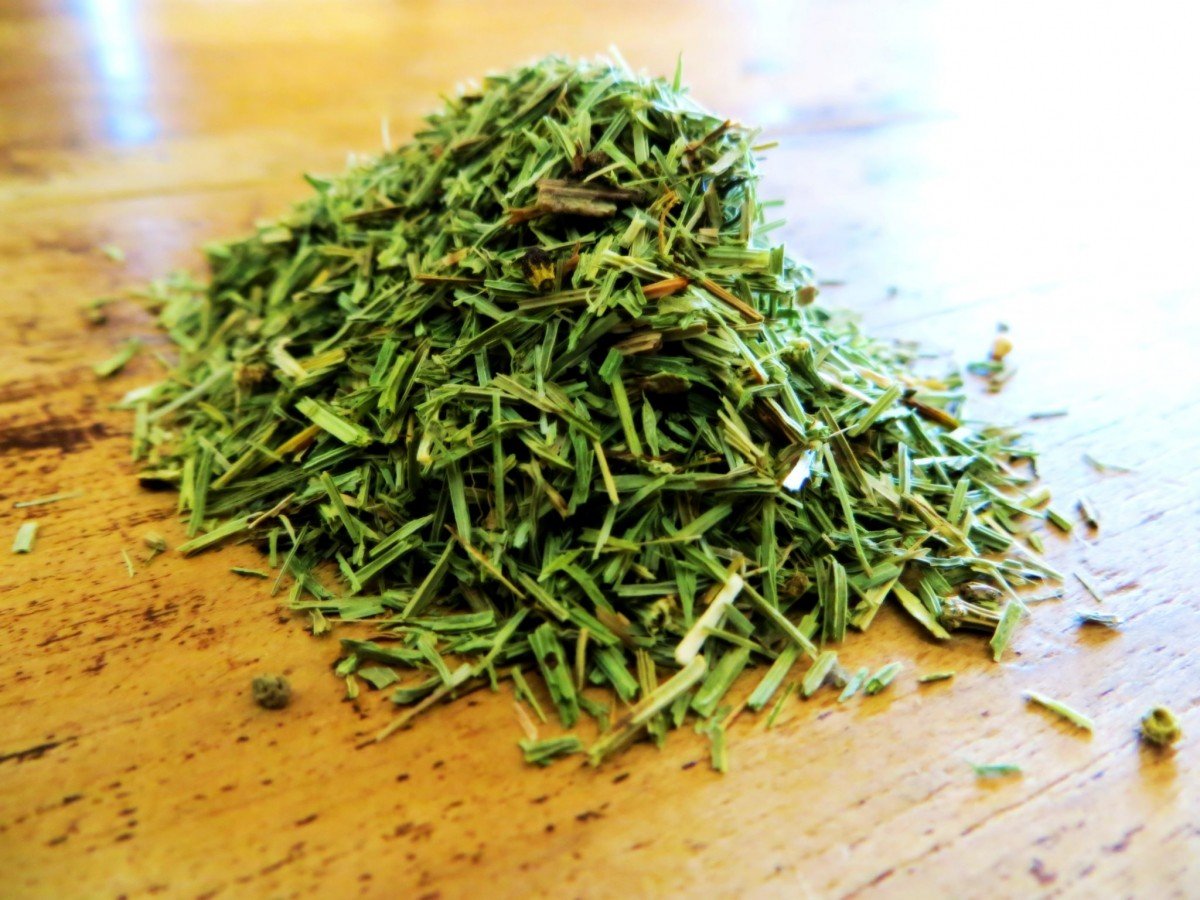
Horsetail Shampoo Bar Recipe
Ingredients
Oils
- 8 ounces coconut oil
- 8 ounces olive oil
- 8 ounces organic, sustainably-sourced palm oil
- 4 ounces shea butter
- 2 ounces cocoa butter
- 3 ounces castor oil
Liquid
- 10 fluid ounces handmade horsetail water infusion, click here to learn how to make an herbal water infusion
- 4.52 ounces lye (7% excess fat)
Add-Ins
- 1 tablespoons horsetail powder
- 2 ounces argan oil
- 2 ounces essential oil blend of ylang ylang, bay, clary sage, sweet orange, and cedarwood
Soap-Making Basics
Thanks to the Internet and amazing people who are willing to share their wisdom so freely…I was able to learn the skill. I primarily use the hot processed method…however, choose the method you feel most comfortable with:
- Wardeh, who runs Gnowfglins, on her personal blog Such Treasures gives the clearest, most easy to follow directions ever! This is the exact post that got me started. She uses the hot processed method and I highly recommend that you read her recipe if you are even the slightest bit interested in making your own soap.
- Renee of Fimby was also very inspirational and such a great resource! Watch her awesome video that describes the cold processed method for making a simple soap by clicking here.
If you are new to soap-making, I strongly suggest you read through these very informative articles and find what will work for you:
I would also recommend borrowing a few of these books from the library if you really find yourself wanting to know more:
- Handcrafted Soapby Dolores Boone
- The Soapmaker’s Companionby Susan Miller Cavitch
- The Natural Soap Book by Susan Miller Cavitch
Hot Process Method
*Remember…there are 2 different methods for soap-making — hot and cold process — this is the Hot Process Method.
- Measure both the lye and herbal infusion – each in separate bowls — using a kitchen scale. Note: Always run your recipe through a lye calculator to be sure that you are using the proper amount of oils, lye, and liquid.
- Carefully combine the lye and herbal infusion by pouring the lye into the liquid (never pour liquid into the lye) and stir liquid until lye is completely dissolved. The liquid is caustic and not to be touched in anyway. The outside of the bowl will be extremely hot as well. Be careful when working with lye and follow all of the recommended precautions. Note: What I’m trying to say is, I can not be held responsible for any craziness, mishaps, explosions, etc. that may happen when making this recipe.
- Allow the lye mixture to stay under a vent and cool down while you prepare the oils.
- Measure the oils – by weight – and then place in a crock pot to melt on low heat. Please omit the essential oils…we will be adding them later.
- Once melted, add the lye/water mixture to the oils in the crock pot and stir. Note: Any equipment the lye touches needs to be neutralized in a mixture of white vinegar, soap, and water.
- After a brief stir, grab your stick blender and get to work! Blend the oils and liquid in the crock pot for at least 1-2 minutes. We are working toward “trace.”
- After 1-2 minutes, add the horsetail powder. Using a wire whisk, whisk until well combined.
- Continue whisking for 2-3 minutes more – until the mixture becomes a thick, pudding like consistency.
- Once the mixture is pudding-like, cover the crock pot and “cook” the soap, on low heat, for approximately 1 hour.
- Prepare your mold. Note: I just use a standard loaf pan lined with parchment paper and it’s always worked perfectly and this recipe is enough to fill one loaf pan.
- Once the soap is done “cooking” remove from heat and quickly add the essential oils and argan oil.
- Stir until well combined.
- Spoon soap mixture into molds.
- Allow soap to cool and harden for 24 hours.
- Remove from mold on to cutting board and cut into bars.
- Place bars on a tray with good airflow so that they can harden further.
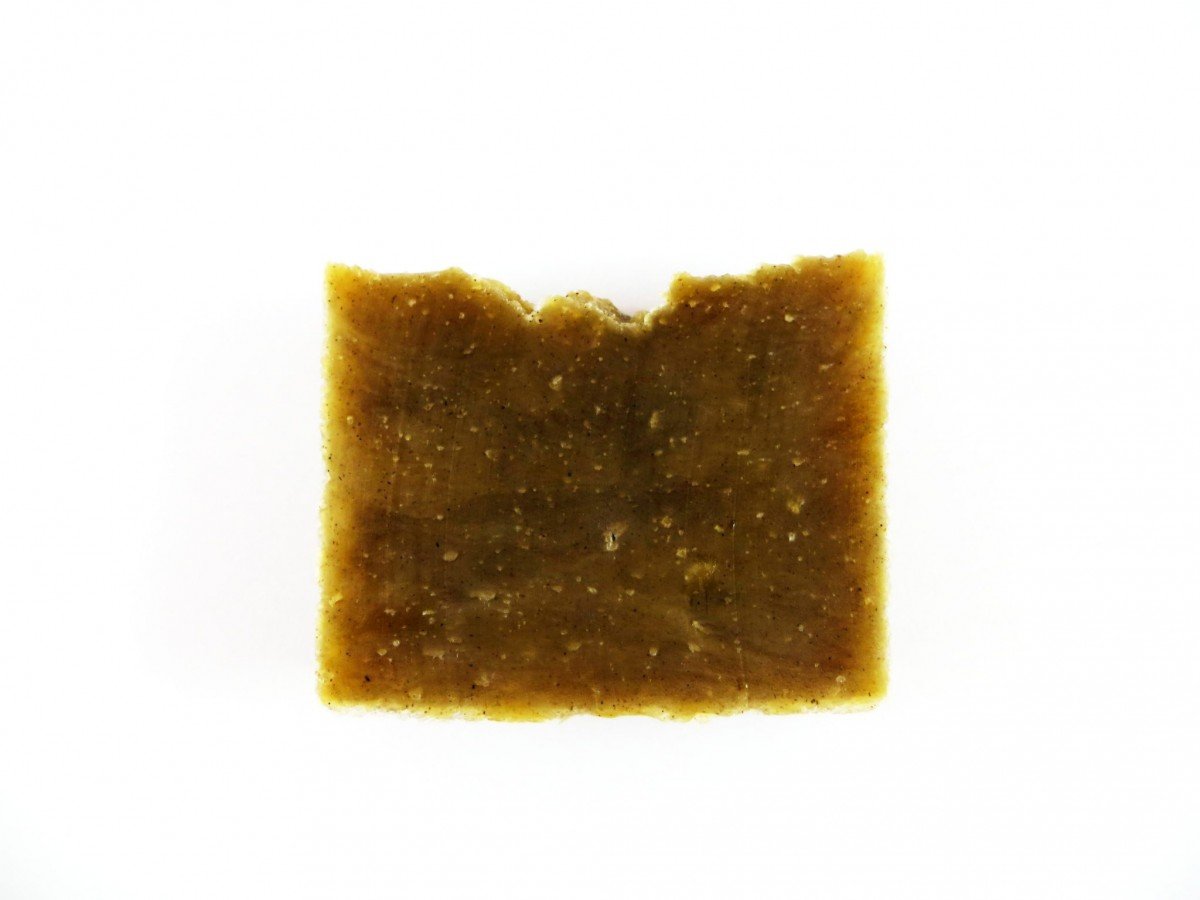
Where Can I Get This Stuff
–Mountain Rose Herbs…they have everything (dried herbs and quality oils) you’ll need for this soap! It’s your one-stop-shop!
-I also just love the people over at The Soap Dish. You can purchase lye and other ingredients necessary for this recipe.
–The Bulk Herb Store also carries many of these ingredients if you’d like to price check.

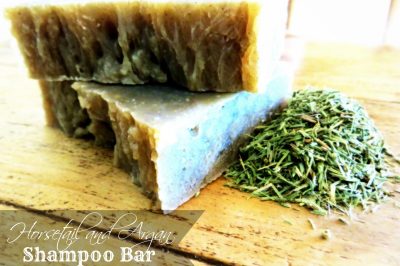
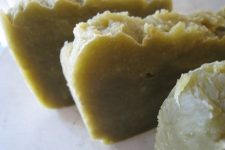
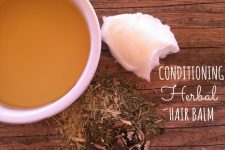
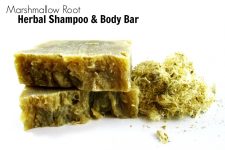
 How to Make an Herbal Tallow Beauty Balm
How to Make an Herbal Tallow Beauty Balm
oh no! Looks like I’ll be splurging on a few more essential oils, because this looks like a fantastic shampoo 🙂
Haha 🙂 So far it’s my favorite! My hair is silky smooth and so shiny! Not to mention, the combo of essential oils is divine. You’ll love it!
How long does it have to cure? I thought it was a few weeks.
Andrea-again, thanks for sharing another great recipe. I’ll be due to make another batch of shampoo bars and I will be using this recipe.
In hot process, the soap is heated to allow the chemical process of saponification to occur and when you finish “cooking” the soap, it is ready to use. It still is recommended to let the bars sit after they are cut to allow more of the water to evaporate to produce a harder and longer lasting bar. I love that I don’t have to wait to try the first bar!
LOVE your stuff–keep it up
from Big Fan! :0)
I always have a problem with ‘lye’! Do you mean SODIUM hydroxide or POTASSIUM hydroxide? Sodium normally used for cold process and potassium usually used for hot….?
Sodium hydroxide is used for making bar soaps. Potassium hydroxide is used for making liquid soaps. A combo of both is used for making cream soaps.
i like your all recipes keep it up
I love them all, too. I’ve never made soap before, and I’m a bit intimidated I’ll admit. I think I might like to try the crock pot soap. I’m saving all these recipes so if I get the courage up I’ll try it.
Do you think it may work for curly hair? When you remove soap from heat, do you take the pot out of crock or pour in something else?
Andrea, Not sure if you know this or not, but once the bars are cooked and cooled and cut into bars, it is possible to reheat them to liquid stage to add additional essential oils in case they need more scent? And is it possible to make them into a liquid soap?
If you have soap that you’ve already made but it’s a bit caustic or you want to add more fragrance/essential oils, etc., you can grate the soap and “rebatch” the soap. Do an internet search for the process. Some soapers do this to add some ingredients (essential oils and other additives) to the rebatched soap in order to avoid the lye reacting with it too soon and “using up” the special oils/additives.
Also, if you’re selling homemade soaps or other products, be very careful not to make claims. If you do, the FDA deems your product as a drug rather than just soap or a cosmetic.. Check out this article about that: http://blog.mariegale.com/more-on-product-claims/
Suzy,
I was specifically thinking that I would like to make some soap without any scents and then as the seasons come and go, if it is possible to melt them so that I can add scents to them, I would add whatever EO’s or scents I would like at the time in just one or two bars rather than making several batches of soap for say 6 different scents. I will definitely look up the rebatching process.
And thank you for the FDA information. I am not selling my products–just making them for myself, but it is good info for the future for soaps or salves or any other type of remedy. 🙂
Thanks so much! 🙂
In my opinion, it would be better to make a different batch for each scent blend, as homemade soaps don’t really “melt”. You can adjust the recipe (using the same percentages) to fit a small mold (or a cavity mold) to get 1 or 2 soaps out of a batch. Rebatching is a lot of work.
Thanks! I would guess that I could just put it through a lye calculator to make a smaller batch. Good idea.
You could also separate the soap into different containers after you “cooked” it, add the scents/essential oils and then put them in smaller molds. I’ve used “milk” style coated cardboard cartons that I purchase my buttermilk in. And I’ve seen reference to the use of Pringle cans (only safe with Hot Processed Soap). Good luck and have fun!
Good idea! I like that idea. Thanks for the the help.
On your essential oil blend, would it be equal amounts of each essential oil to equal the 2 oz?
Hi there, What size crock pot do we need to use? I looked but can’t find anywhere what size to use.
Also: Is there any other oil to use besides Palm Oil?
Thank you!!
Beef Tallow is a good alternative for Palm Oil; it’s what I use. 🙂
Can other essential oils be used in this recipe or is it important to use the ones stated?
Thank you!!
I was wondering how much of each essential oil to use. Thanks, I can’t wait to try making it!
i have made this twice and both times it was fine. I did rebatch last time and it is even better with goats milk in it. I am going to try it cold process next time. I may still rebatch the the only extra work is grating it.. I do take andrewlessmans healthy hair and nails. I was losing my hair and now my hair is growing back. I am menopausal and this keeps the frizz down in my hair too.
Thank you